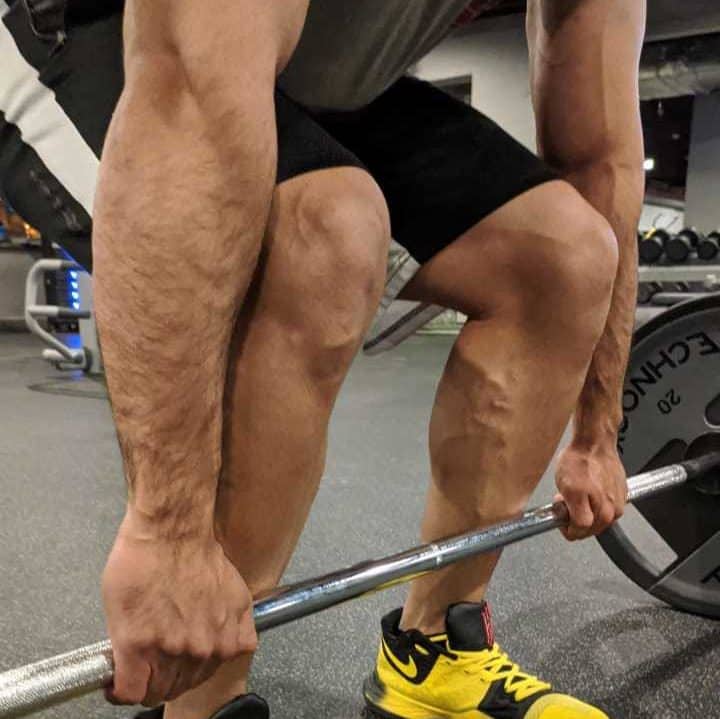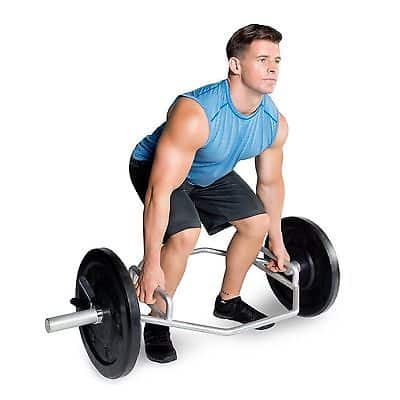Key Points
- Deadlifts increase the strength of your jumping muscles and produce more power at the bottom of the movement.
- Any form of deadlift would be beneficial for jumping from their similarities in biomechanics.
- The hex bar deadlift forces more load on the human kinetic chain (jumping movement).
Deadlifts are such a great fundamental exercise for all sports.
Most sports require some sort of vertical jump or power to generate through the legs. Coaches and trainers implement different types of agility exercises to get their players ready and stack performance. But what about deadlifts?
Do deadlifts help vertical jump? Yes! Deadlifts help with increasing the amount of force produced from the legs and hips. At the bottom of a jump, this force translates to strength and a higher vertical jump. Deadlifts also help prevent injuries during jumps by strengthening tendons in the legs.
Let’s get into the details of the effect of deadlifts on vertical jump.
Deadlifts and Vertical Jump
Anyone who has been hovering around the weights room in the gym should be familiar with the deadlift.
It starts with a hip hinge and grasping a loaded barbell. Then pushes off the ground with the legs, while pulling the weight with the upper body.
In the vertical jump, you would draw into a similar semi-crouched position. You would then pause at the bottom, then drive from the legs to take off from the ground. The aim is to reach vertically as far up as possible.
This movement is used during certain settings of sports like basketball, tennis, and football.
Do Hip Thrusts Help You Jump Higher? Yes, Here’s How
How Do Deadlifts Increase Vertical Jump?
Now we know the movement patterns between deadlifts and vertical jump. But how does this relate to the increased power from one movement to the other?
For this, we will be using various studies showing the effect of deadlifts on vertical jump.
1. Deadlifts Mimic Vertical Jump Movement
An extension from the previous section, deadlifts look and feel like jumping. The movement has similarities to the raising part of the deadlift.
This movement pattern can help with patterning and conditioning during sport related mobility.
If you know how to efficiently deadlift, you will be able to duplicate the pattern during a vertical jump.
2. Deadlifts Increase Force Production
In a recent study, resistance-trained men underwent training twice a week for 4 weeks. The volume and load were increased in the first 2 weeks. The men’s deadlift 1RM increased as well as their vertical jump. Overall, the vertical jump increased by 2.1%.
Although this seems small, you should take note that these individuals already had a high vertical jump of 56 cm. At that level, they would be good basketball players.
In addition, take into consideration that this was over 4 weeks of training. Imagine what a year of consistent training could accomplish.
Do Deadlifts Help with Wrestling Moves? Yes!
3. Deadlifts Increase Torque
Another study showed an increase of 7% vertical jump in newly trained individuals after they underwent 10 weeks of deadlift training.
Specifically, the study in 2015 showed stronger knee flexors and extensors. These are the prime leg muscles involved in jumping. Think of how you bend down. The knee extensors help you straighten your leg.
The torque (a measure of power) increased over the 10 weeks of deadlift training. Hence, the lifters were able to jump higher by 7%.
4. Deadlifts Strengthen Tendons
It’s known that strength training can stiffen tendons.
So what good would come from stiffening tendons while vertical jumping?
Looking at the purpose of tendons, we see that they translate force from muscle to bone. Stronger tendons mean more efficient force transfer from muscle to bone.
In addition, your knees will thank you for helping strengthen the joint involved in jumping. Jumping can take a toll on your joint and without the proper conditioning, it could lead to an injury.

5. Deadlifts are a General and Special Exercise
Rounding out the fifth way how deadlifts increase vertical jump is the specificity.
Scientists and coaches classify different exercises according to how they contribute to the vertical jump.
General exercises help increase the maximal strength of the muscles involved in jumping. Such as squats or front squats.
Special strength exercises apply the new strength for power or explosiveness. These types of exercises usually involve some sort of jumping. Specific exercises aim to provide a similar stimulation compared to sport. For instance, jumping with a weight to the waist or repetitive jumping.
The deadlift is a general and special exercise for vertical jump.
Deadlifts increase the strength of the muscles involved. But, deadlifts can also increase power through rapid explosiveness.
Deadlift Accessory Exercises- Improve Strength and Technique
The Best Deadlift for Vertical Jump
Any form of deadlift would be beneficial for jumping from their similarities in biomechanics.
The deadlift variant that stands out the most, in terms of specificity is the hex bar deadlift.
The hex bar is a hexagon shape barbell that weighs 55-60 pounds.
A lifter should be mindful of this, as it is slightly heavier than the Olympic or deadlift bar.
To use the hex bar, a lifter would stand in the center and grip a pair of vertical handles.
The lifter can then perform the deadlift as shown in the image.

The hex bar deadlift forces more load on the human kinetic chain (jumping movement). So, it reaps more of the maximal strength and strength-speed component of jumping power.
Biomechanics
If we put both movements side by side, it is clear that they have a similar movement pattern (1). If we break down each movement, it would look like:
Plantar Flexion
Ankle plantar flexion comes into play to start the movements. The weight is primarily pressed on the balls of the feet.
Knee Extension
After pressing from the feet the force is transferred to the upper leg. The upper leg extends the knee, or as we know it straightens the leg.
Hip Extension
Towards the end of both movements, we can see that they draw a hip extension, which is straightening at the lower body.
Scapula Retraction
The last phase is where the movements differ slightly.
At this point, during the vertical jump, the force transferred through the lower body would elevate you off of the ground.
This would be followed by stretching the arms upwards, and retracting the scapula by default (pinning the shoulder back). All before the force of gravity would bring the individual back down.
For the hex bar deadlift, the weight would be pulled closer to the hips while pinning the shoulder blades back. After completing the deadlift you would drop the weight back onto the ground.
Muscle Activation
It would only make sense that both exercises would work for the same muscle groups as the movement mechanics are similar. These muscle groups include (2):
- Calf Muscles
- Quadriceps
- Hamstrings
- Glutes
- Core
- Trapezius
Centre of Gravity
What makes the hex bar deadlift so unique and specific to the vertical jump is where the weight is lifted from (1).
If we look at a conventional deadlift, the weightlifting would be lifted from the front. Whereas the hex bar would come from the side of the body.
Do Deadlifts Work Your Traps? Yes, Here’s How
The center of gravity from the hex bar would support a more natural movement identical to the vertical jump. In contrast to the conventional barbell deadlift, which may force more forward lean.
How to Perform Hex Bar Deadlift?
Here is the guideline to performing the hex bar deadlift.
STEP 1: Find a clear space in the gym suitable for deadlifting with the hex bar. The squat rack is perfect.
STEP 2: Place a Hex bar on the floor. Load the hex bar depending on your training phase, i.e., 75% intensity x 12 reps x 5 sets (Speed-Strength).
STEP 3: Stand in the center of the hex bar. Place the feet in your natural jumping position.
STEP 4: Grasp the vertical handles in a position where it feels most comfortable.
STEP 5: Drop the hips. Bend at the knees and shift your weight to your heels.
STEP 6: Change the position of your feet, if needed. Take a deep breath and brace the muscles on the trunk, especially the core.
STEP 7: Press from the ball of the foot while straightening the knee/hips.
STEP 8: Finish by bringing the weight up and pinning the shoulder blades backwards. Breathe out and place the bar back to the starting point.
STEP 9: Repeat the movement.
Other Ways to Increase Vertical Jump
Though deadlifts will help with vertical jump, you can use various other exercises as well.
Plyometric training will help with producing more power and simulating sport environments.
Performing squats will further strengthen the quads, calves, and hamstrings which are all critical in jumping.
An underrated exercise for jumping is hip thrust. Hip thrusts can strengthen your glutes and your power from the bottom of the jumping movement.
Best Alternatives to Barbell Hip Thrust
Final Thoughts
All in all, the deadlift can add resistance and strengthen the same movement pattern and muscle groups used in the vertical jump.
If you’re an athlete or in any sort of recreational sports, deadlifts can benefit you greatly. Vertical jump level can translate to other athletic pursuits, not just basketball.
Try the deadlift today and see how your vertical jump improves.
Frequently Asked Questions
Yes, deadlifts increase the strength of your jumping muscles and produce more power at the bottom of the movement.
Hex bar or trap bar deadlifts are the best variations to help increase your vertical jump. These deadlifts mimic the jumping movement pattern and use similar muscle groups.
Squats, hip thrusts, deadlifts and plyometric movements will all help you jump higher. Start by strengthening your lower body muscles and then using explosive movements to mimic jumping.
References
- Munger, C.N., Leyva, W.D., Archer, D.C., et al. ‘Comparison of Hex Bar Deadlift vs. Back Squat Postactivation Potentiation on Vertical Jump Takeoff Velocity’ Medicine And Science In Sport And Exercise. 2016; 48(5): 935–935
- Camara, K. ‘An examination of muscle activation and power characteristics while performing the deadlift exercise with straight and hexagonal barbells’ California State University, Fullerton. 2015 (Dissertation thesis)
More on Deadlifts:





